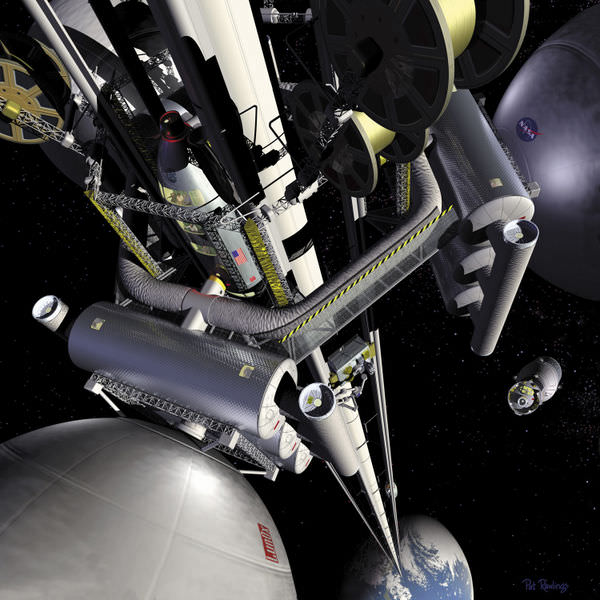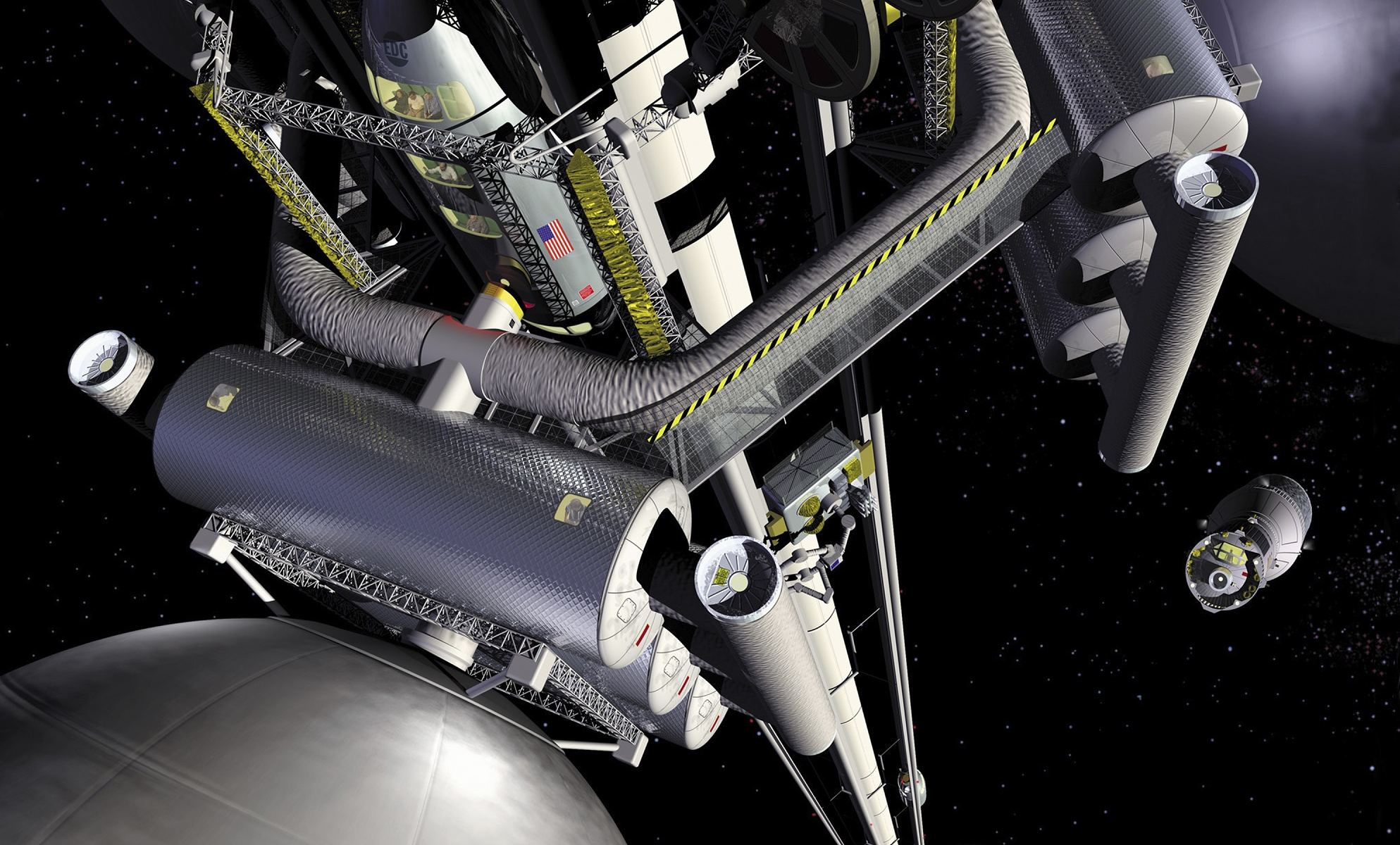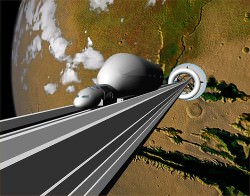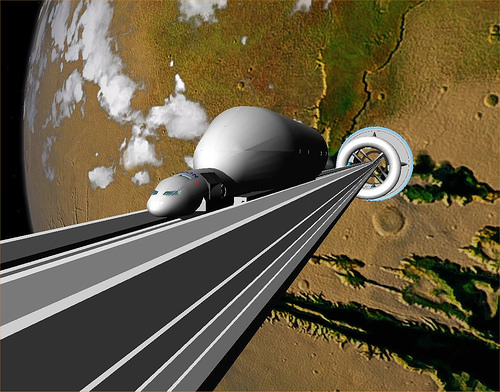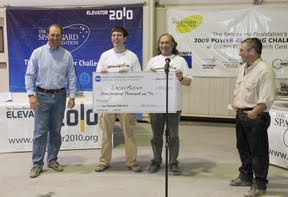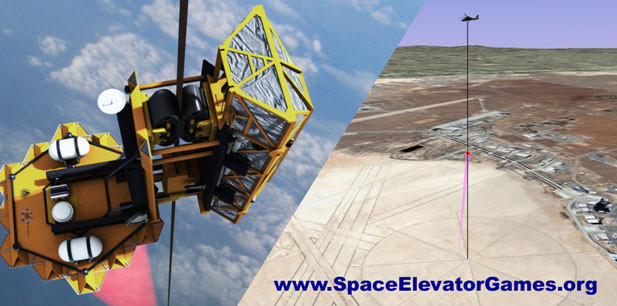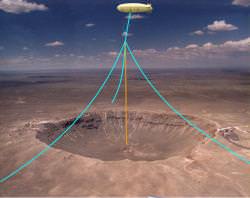Here at UT, we’ve had several stories that describe the concept of a space elevator. They are designed to make it easier to get objects off Earth and into space. That, so far, has proven technically or economically infeasible, as no material is strong enough to support the structure passively, and it’s too energy-intensive to support it actively. However, it could be more viable on other worlds, such as the Moon. But what about worlds farther afield? A student team from the University of Colorado at Colorado Springs looked at the use case of a space elevator on Ceres and found that it could be done with existing technology.
Continue reading “Using A Space Elevator To Get Resources Off the Queen of the Asteroid Belt”The Spaceline: an Elevator From the Earth to the Moon
Humanity’s future may lie in space, but getting out there is a very big challenge. In short, launching payloads into space from the bottom of Earth’s gravity well is quite expensive, regardless of whether or not reusable rockets are involved. And while some have suggested that building a Space Elevator would be a long-term solution to this problem, this concept is also very expensive and presents all kinds of engineering hurdles.
As an alternative, a pair of astronomy gradu
A Japanese Company is About to Test a Tiny Space Elevator… in Space
Let’s be honest, launching things into space with rockets is a pretty inefficient way to do things. Not only are rockets expensive to build, they also need a ton of fuel in order to achieve escape velocity. And while the costs of individual launches are being reduced thanks to concepts like reusable rockets and space planes, a more permanent solution could be to build a Space Elevator.
And while such a project of mega-engineering is simply not feasible right now, there are many scientists and companies around the world that are dedicated to making a space elevator a reality within our lifetimes. For example, a team of Japanese engineers from Shizuoka University‘s Faculty of Engineering recently created a scale model of a space elevator that they will be launching into space tomorrow (on September 11th).
Continue reading “A Japanese Company is About to Test a Tiny Space Elevator… in Space”
Colonizing the Inner Solar System
Science fiction has told us again and again, we belong out there, among the stars. But before we can build that vast galactic empire, we’ve got to learn how to just survive in space. Fortunately, we happen to live in a Solar System with many worlds, large and small that we can use to become a spacefaring civilization.
This is half of an epic two-part article that I’m doing with Isaac Arthur, who runs an amazing YouTube channel all about futurism, often about the exploration and colonization of space. Make sure you subscribe to his channel.
This article is about colonizing the inner Solar System, from tiny Mercury, the smallest planet, out to Mars, the focus of so much attention by Elon Musk and SpaceX. In the other article, Isaac will talk about what it’ll take to colonize the outer Solar System, and harness its icy riches. You can read these articles in either order, just read them both.
At the time I’m writing this, humanity’s colonization efforts of the Solar System are purely on Earth. We’ve exploited every part of the planet, from the South Pole to the North, from huge continents to the smallest islands. There are few places we haven’t fully colonized yet, and we’ll get to that.
But when it comes to space, we’ve only taken the shortest, most tentative steps. There have been a few temporarily inhabited space stations, like Mir, Skylab and the Chinese Tiangong Stations.
Our first and only true colonization of space is the International Space Station, built in collaboration with NASA, ESA, the Russian Space Agency and other countries. It has been permanently inhabited since November 2nd, 2000. Needless to say, we’ve got our work cut out for us.
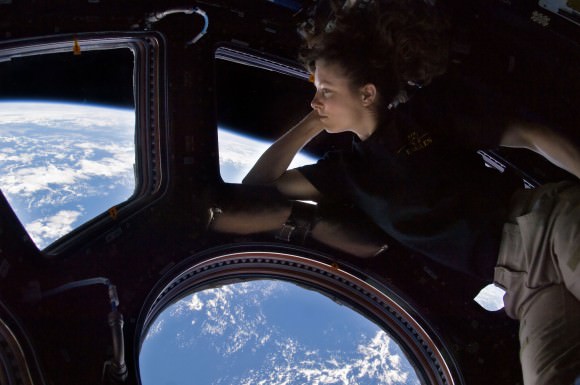
Before we talk about the places and ways humans could colonize the rest of the Solar System, it’s important to talk about what it takes to get from place to place.
Just to get from the surface of Earth into orbit around our planet, you need to be going about 10 km/s sideways. This is orbit, and the only way we can do it today is with rockets. Once you’ve gotten into Low Earth Orbit, or LEO, you can use more propellant to get to other worlds.
If you want to travel to Mars, you’ll need an additional 3.6 km/s in velocity to escape Earth gravity and travel to the Red Planet. If you want to go to Mercury, you’ll need another 5.5 km/s.
And if you wanted to escape the Solar System entirely, you’d need another 8.8 km/s. We’re always going to want a bigger rocket.
The most efficient way to transfer from world to world is via the Hohmann Transfer. This is where you raise your orbit and drift out until you cross paths with your destination. Then you need to slow down, somehow, to go into orbit.
One of our primary goals of exploring and colonizing the Solar System will be to gather together the resources that will make future colonization and travel easier. We need water for drinking, and to split it apart for oxygen to breathe. We can also turn this water into rocket fuel. Unfortunately, in the inner Solar System, water is a tough resource to get and will be highly valued.
We need solid ground. To build our bases, to mine our resources, to grow our food, and to protect us from the dangers of space radiation. The more gravity we can get the better, since low gravity softens our bones, weakens our muscles, and harms us in ways we don’t fully understand.
Each world and place we colonize will have advantages and disadvantages. Let’s be honest, Earth is the best place in the Solar System, it’s got everything we could ever want and need. Everywhere else is going to be brutally difficult to colonize and make self-sustaining.
We do have one huge advantage, though. Earth is still here, we can return whenever we like. The discoveries made on our home planet will continue to be useful to humanity in space through communications, and even 3D printing. Once manufacturing is sophisticated enough, a discovery made on one world could be mass produced half a solar system away with the right raw ingredients.
We will learn how to make what we need, wherever we are, and how to transport it from place to place, just like we’ve always done.

Mercury is the closest planet from the Sun, and one of the most difficult places that we might attempt the colonize. Because it’s so close to the Sun, it receives an enormous amount of energy. During the day, temperatures can reach 427 C, but without an atmosphere to trap the heat, night time temperatures dip down to -173 C. There’s essentially no atmosphere, 38% the gravity of Earth, and a single solar day on Mercury lasts 176 Earth days.
Mercury does have some advantages, though. It has an average density almost as high as Earth, but because of its smaller size, it actually means it has a higher percentage of metal than Earth. Mercury will be incredibly rich in metals and minerals that future colonists will need across the Solar System.
With the lower gravity and no atmosphere, it’ll be far easier to get that material up into orbit and into transfer trajectories to other worlds.
But with the punishing conditions on the planet, how can we live there? Although the surface of Mercury is either scorching or freezing, NASA’s MESSENGER spacecraft turned up regions of the planet which are in eternal shadow near the poles. In fact, these areas seem to have water ice, which is amazing for anywhere this close to the Sun.
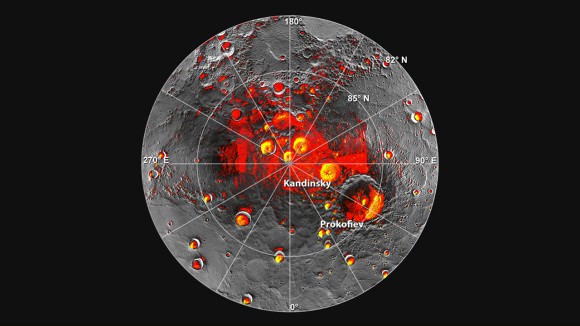
You could imagine future habitats huddled into those craters, pulling in solar power from just over the crater rim, using the reservoirs of water ice for air, fuel and water.
High powered solar robots could scour the surface of Mercury, gathering rare metals and other minerals to be sent off world. Because it’s bathed in the solar winds, Mercury will have large deposits of Helium-3, useful for future fusion reactors.
Over time, more and more of the raw materials of Mercury will find their way to the resource hungry colonies spread across the Solar System.
It also appears there are lava tubes scattered across Mercury, hollows carved out by lava flows millions of years ago. With work, these could be turned into safe, underground habitats, protected from the radiation, high temperatures and hard vacuum on the surface.
With enough engineering ability, future colonists will be able to create habitats on the surface, wherever they like, using a mushroom-shaped heat shield to protect a colony built on stilts to keep it off the sun-baked surface.
Mercury is smaller than Mars, but is a good deal denser, so it has about the same gravity, 38% of Earth’s. Now that might turn out to be just fine, but if we need more, we have the option of using centrifugal force to increase it. Space Stations can generate artificial gravity by spinning, but you can combine normal gravity with spin-gravity to create a stronger field than either would have.
So our mushroom habitat’s stalk could have an interior spinning section with higher gravity for those living inside it. You get a big mirror over it, shielding you from solar radiation and heat, you have stilts holding it off the ground, like roots, that minimize heat transfer from the warmer areas of ground outside the shield, and if you need it you have got a spinning section inside the stalk. A mushroom habitat.

Venus is the second planet in the Solar System, and it’s the evil twin of Earth. Even though it has roughly the same size, mass and surface gravity of our planet, it’s way too close to the Sun. The thick atmosphere acts like a blanket, trapping the intense heat, pushing temperatures at the surface to 462 C.
Everywhere on the planet is 462 C, so there’s no place to go that’s cooler. The pure carbon dioxide atmosphere is 90 times thicker than Earth, which is equivalent to being a kilometer beneath the ocean on Earth.
In the beginning, colonizing the surface of Venus defies our ability. How do you survive and stay cool in a thick poisonous atmosphere, hot enough to melt lead? You get above it.
One of the most amazing qualities of Venus is that if you get into the high atmosphere, about 52.5 kilometers up, the air pressure and temperature are similar to Earth. Assuming you can get above the poisonous clouds of sulphuric acid, you could walk outside a floating colony in regular clothes, without a pressure suit. You’d need a source of breathable air, though.
Even better, breathable air is a lifting gas in the cloud tops of Venus. You could imagine a future colony, filled with breathable air, floating around Venus. Because the gravity on Venus is roughly the same as Earth, humans wouldn’t suffer any of the side effects of microgravity. In fact, it might be the only place in the entire Solar System other than Earth where we don’t need to account for low gravity.
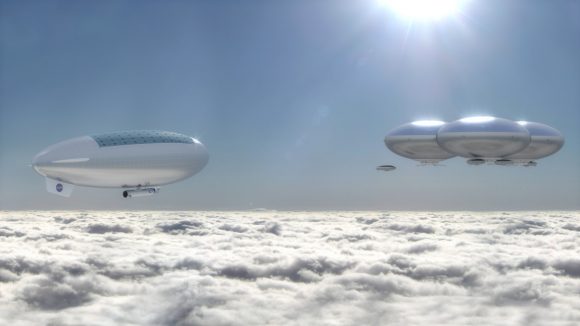
Now the day on Venus is incredibly long, 243 earth days, so if you stay over the same place the whole time it would be light for four months then dark for four months. Not ideal for solar power on a first glance, but Venus turns so slowly that even at the equator you could stay ahead of the sunset at a fast walk.
So if you have floating colonies it would take very little effort to stay constantly on the light side or dark side or near the twilight zone of the terminator. You are essentially living inside a blimp, so it may as well be mobile. And on the day side it would only take a few solar panels and some propellers to stay ahead. And since it is so close to the Sun, there’s plenty of solar power. What could you do with it?
The atmosphere itself would probably serve as a source of raw materials. Carbon is the basis for all life on Earth. We’ll need it for food and building materials in space. Floating factories could process the thick atmosphere of Venus, to extract carbon, oxygen, and other elements.
Heat resistant robots could be lowered down to the surface to gather minerals and then retrieved before they’re cooked to death.
Venus does have a high gravity, so launching rockets up into space back out of Venus’ gravity well will be expensive.
Over longer periods of time, future colonists might construct large solar shades to shield themselves from the scorching heat, and eventually, even start cooling the planet itself.

The next planet from the Sun is Earth, the best planet in the Solar System. One of the biggest advantages of our colonization efforts will be to get heavy industry off our planet and into space. Why pollute our atmosphere and rivers when there’s so much more space… in space.
Over time, more and more of the resource gathering will happen off world, with orbital power generation, asteroid mining, and zero gravity manufacturing. Earth’s huge gravity well means that it’s best to bring materials down to Earth, not carry them up to space.
However, the normal gravity, atmosphere and established industry of Earth will allow us to manufacture the lighter high tech goods that the rest of the Solar System will need for their own colonization efforts.
But we haven’t completely colonized Earth itself. Although we’ve spread across the land, we know very little about the deep ocean. Future colonies under the oceans will help us learn more about self-sufficient colonies, in extreme environments. The oceans on Earth will be similar to the oceans on Europa or Enceladus, and the lessons we learn here will teach us to live out there.
As we return to space, we’ll colonize the region around our planet. We’ll construct bigger orbital colonies in Low Earth Orbit, building on our lessons from the International Space Station.
One of the biggest steps we need to take, is understanding how to overcome the debilitating effects of microgravity: the softened bones, weakened muscles and more. We need to perfect techniques for generating artificial gravity where there is none.
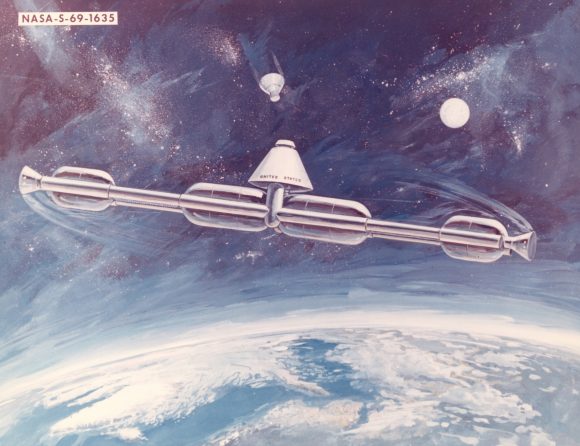
The best technique we have is rotating spacecraft to generate artificial gravity. Just like we saw in 2001, and The Martian, by rotating all or a portion of a spacecraft, you can generated an outward centrifugal force that mimics the acceleration of gravity. The larger the radius of the space station, the more comfortable and natural the rotation feels.
Low Earth Orbit also keeps a space station within the Earth’s protective magnetosphere, limiting the amount of harmful radiation that future space colonists will experience.
Other orbits are useful too, including geostationary orbit, which is about 36,000 kilometers above the surface of the Earth. Here spacecraft orbit the Earth at exactly the same rate as the rotation of Earth, which means that stations appear in fixed positions above our planet, useful for communication.
Geostationary orbit is higher up in Earth’s gravity well, which means these stations will serve a low-velocity jumping off points to reach other places in the Solar System. They’re also outside the Earth’s atmospheric drag, and don’t require any orbital boosting to keep them in place.
By perfecting orbital colonies around Earth, we’ll develop technologies for surviving in deep space, anywhere in the Solar System. The same general technology will work anywhere, whether we’re in orbit around the Moon, or out past Pluto.
When the technology is advanced enough, we might learn to build space elevators to carry material and up down from Earth’s gravity well. We could also build launch loops, electromagnetic railguns that launch material into space. These launch systems would also be able to loft supplies into transfer trajectories from world to world throughout the Solar System.
Earth orbit, close to the homeworld gives us the perfect place to develop and perfect the technologies we need to become a true spacefaring civilization. Not only that, but we’ve got the Moon.
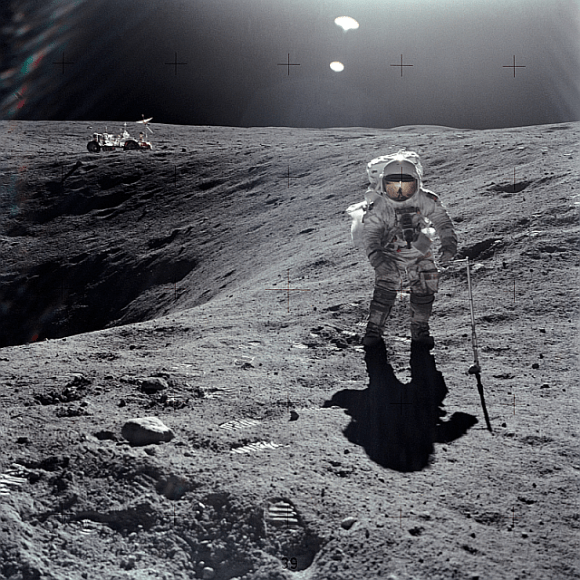
The Moon, of course, is the Earth’s only natural satellite, which orbits us at an average distance of about 400,000 kilometers. Almost ten times further than geostationary orbit.
The Moon takes a surprising amount of velocity to reach from Low Earth Orbit. It’s close, but expensive to reach, thrust speaking.
But that fact that it’s close makes the Moon an ideal place to colonize. It’s close to Earth, but it’s not Earth. It’s airless, bathed in harmful radiation and has very low gravity. It’s the place that humanity will learn to survive in the harsh environment of space.
But it still does have some resources we can exploit. The lunar regolith, the pulverized rocky surface of the Moon, can be used as concrete to make structures. Spacecraft have identified large deposits of water at the Moon’s poles, in its permanently shadowed craters. As with Mercury, these would make ideal locations for colonies.
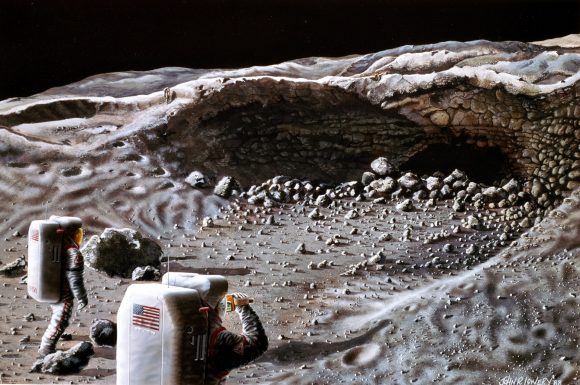
Our spacecraft have also captured images of openings to underground lava tubes on the surface of the Moon. Some of these could be gigantic, even kilometers high. You could fit massive cities inside some of these lava tubes, with room to spare.
Helium-3 from the Sun rains down on the surface of the Moon, deposited by the Sun’s solar wind, which could be mined from the surface and provide a source of fuel for lunar fusion reactors. This abundance of helium could be exported to other places in the Solar System.
The far side of the Moon is permanently shadowed from Earth-based radio signals, and would make an ideal location for a giant radio observatory. Telescopes of massive size could be built in the much lower lunar gravity.
We talked briefly about an Earth-based space elevator, but an elevator on the Moon makes even more sense. With the lower gravity, you can lift material off the surface and into lunar orbit using cables made of materials we can manufacture today, such as Zylon or Kevlar.
One of the greatest threats on the Moon is the dusty regolith itself. Without any kind of weathering on the surface, these dust particles are razor sharp, and they get into everything. Lunar colonists will need very strict protocols to keep the lunar dust out of their machinery, and especially out of their lungs and eyes, otherwise it could cause permanent damage.

Although the vast majority of asteroids in the Solar System are located in the main asteroid belt, there are still many asteroids orbiting closer to Earth. These are known as the Near Earth Asteroids, and they’ve been the cause of many of Earth’s great extinction events.
These asteroids are dangerous to our planet, but they’re also an incredible resource, located close to our homeworld.
The amount of velocity it takes to get to some of these asteroids is very low, which means travel to and from these asteroids takes little energy. Their low gravity means that extracting resources from their surface won’t take a tremendous amount of energy.
And once the orbits of these asteroids are fully understood, future colonists will be able to change the orbits using thrusters. In fact, the same system they use to launch minerals off the surface would also push the asteroids into safer orbits.
These asteroids could be hollowed out, and set rotating to provide artificial gravity. Then they could be slowly moved into safe, useful orbits, to act as space stations, resupply points, and permanent colonies.
There are also gravitationally stable points at the Sun-Earth L4 and L5 Lagrange Points. These asteroid colonies could be parked there, giving us more locations to live in the Solar System.
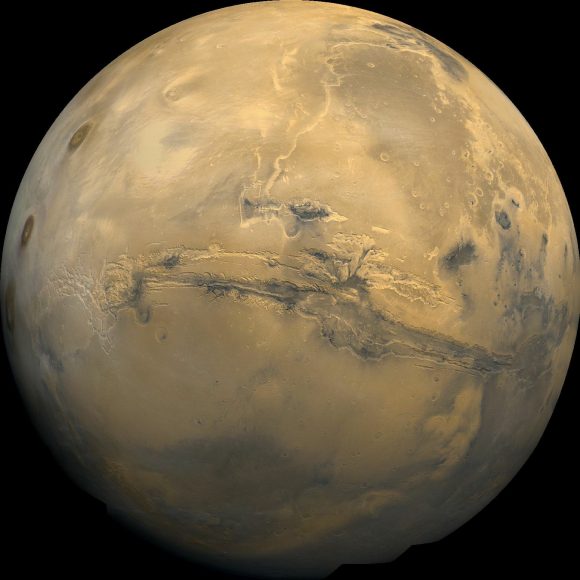
The future of humanity will include the colonization of Mars, the fourth planet from the Sun. On the surface, Mars has a lot going for it. A day on Mars is only a little longer than a day on Earth. It receives sunlight, unfiltered through the thin Martian atmosphere. There are deposits of water ice at the poles, and under the surface across the planet.
Martian ice will be precious, harvested from the planet and used for breathable air, rocket fuel and water for the colonists to drink and grow their food. The Martian regolith can be used to grow food. It does have have toxic perchlorates in it, but that can just be washed out.
The lower gravity on Mars makes it another ideal place for a space elevator, ferrying goods up and down from the surface of the planet.
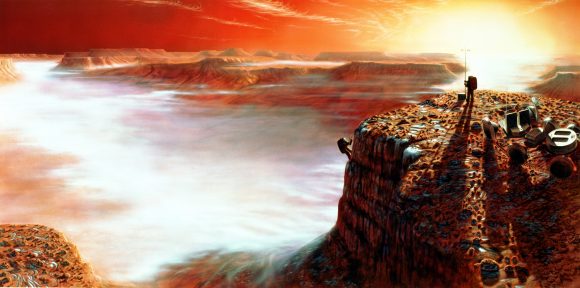
Unlike the Moon, Mars has a weathered surface. Although the planet’s red dust will get everywhere, it won’t be toxic and dangerous as it is on the Moon.
Like the Moon, Mars has lava tubes, and these could be used as pre-dug colony sites, where human Martians can live underground, protected from the hostile environment.
Mars has two big problems that must be overcome. First, the gravity on Mars is only a third that of Earth’s, and we don’t know the long term impact of this on the human body. It might be that humans just can’t mature properly in the womb in low gravity.
Researchers have proposed that Mars colonists might need to spend large parts of their day on rotating centrifuges, to simulate Earth gravity. Or maybe humans will only be allowed to spend a few years on the surface of Mars before they have to return to a high gravity environment.
The second big challenge is the radiation from the Sun and interstellar cosmic rays. Without a protective magnetosphere, Martian colonists will be vulnerable to a much higher dose of radiation. But then, this is the same challenge that colonists will face anywhere in the entire Solar System.
That radiation will cause an increased risk of cancer, and could cause mental health issues, with dementia-like symptoms. The best solution for dealing with radiation is to block it with rock, soil or water. And Martian colonists, like all Solar System colonists will need to spend much of their lives underground or in tunnels carved out of rock.
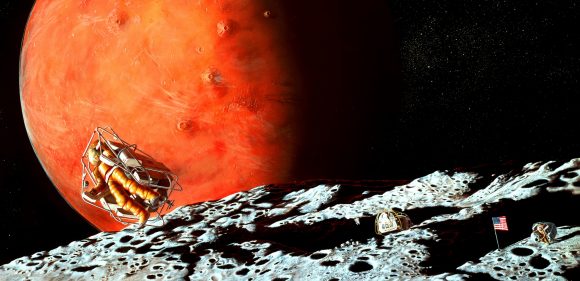
In addition to Mars itself, the Red Planet has two small moons, Phobos and Deimos. These will serve as ideal places for small colonies. They’ll have the same low gravity as asteroid colonies, but they’ll be just above the gravity well of Mars. Ferries will travel to and from the Martian moons, delivering fresh supplies and sending Martian goods out to the rest of the Solar System.
We’re not certain yet, but there are good indicators these moons might have ice inside them, if so that is an excellent source of fuel and could make initial trips to Mars much easier by allowing us to send a first expedition to those moons, who then begin producing fuel to be used to land on Mars and to leave Mars and return home.
According to Elon Musk, if a Martian colony can reach a million inhabitants, it’ll be self-sufficient from Earth or any other world. At that point, we would have a true, Solar System civilization.
Now, continue on to the other half of this article, written by Isaac Arthur, where he talks about what it will take to colonize the outer Solar System. Where water ice is plentiful but solar power is feeble. Where travel times and energy require new technologies and techniques to survive and thrive.
How Do We Terraform The Moon?

Welcome back to our ongoing series, “The Definitive Guide To Terraforming”! We continue with a look at the Moon, discussing how it could one day be made suitable for human habitation.
Ever since the beginning of the Space Age, scientists and futurists have explored the idea of transforming other worlds to meet human needs. Known as terraforming, this process calls for the use of environmental engineering techniques to alter a planet or moon’s temperature, atmosphere, topography or ecology (or all of the above) in order to make it more “Earth-like”. As Earth’s closest celestial body, the Moon has long been considered a potential site.
All told, colonizing and/or terraforming the Moon would be comparatively easy compared to other bodies. Due to its proximity, the time it would take to transport people and equipment to and from the surface would be significantly reduced, as would the costs of doing so. In addition, it’s proximity means that extracted resources and products manufactured on the Moon could be shuttled to Earth in much less time, and a tourist industry would also be feasible.
Continue reading “How Do We Terraform The Moon?”What is a Space Elevator?
Almost every part of a rocket is destroyed during the launch and re-entry into the Earth’s atmosphere. This makes spaceflight really expensive. Rocket delivery of even a single kilogram into orbit costs tens of thousands of dollars. But what if we could just place our payloads directly into orbit, and didn’t need a rocket at all?
This is the idea of a space elevator, first envisioned by the Russian rocket scientist Konstantin Tsiolkovsky in 1895. Tsiolkovsky suggested building a tower all the way up to geostationary orbit, this is the point where a satellite appears to hang motionless in the sky above the Earth. If you could carry spacecraft all the way up to the top, and release them from that tower they’d be in orbit, without the expense of a discarded rocket. A fraction more energy and they’d be traveling away from the Earth to explore the Solar System.
The major flaw with this idea is that the entire weight of the tower would be compressing down on every part below. And there’s no material on Earth, or in the Universe, that can handle this kind of compressive force. But the idea still makes sense.
Newer thinking about space elevators propose using a cable, stretched out beyond geostationary orbit. Here the outward centripetal force counters the force of gravity, keeping the tether perfectly balanced. But now we’re dealing with the tensile strength of a cable tens of thousands of kilometers long.
Imagine the powerful forces trying to tear it apart. Until recently, there was no material strong enough to withstand those forces, but the development of carbon nanotubes has made the idea more possible.
How would you build a space elevator? The most reasonable idea would be to move an asteroid into geostationary orbit – this is your counterbalance. A cable would then be manufactured on the asteroid, and lowered down towards the Earth.
As the cable extends down, the asteroid is orbited further from the Earth, keeping everything in balance. Finally, the cable reaches the Earth’s surface and is attached to a ground station.
Solar powered machines are attached to the space elevator and climb up from the surface of the Earth, all the way to geostationary orbit. Even traveling at a speed of 200 km/hour, it would take the climber almost 10 days to make the journey from the surface to an altitude of 36,000 kilometers. But the cost savings would be dramatic.
Currently, rockets cost about $25,000 per kilogram to send a payload to geostationary orbit. A space elevator could deliver the same payload for $200 per kilo.
Obviously there are risks associated with a megastructure like this. If the cable breaks, portions of it would fall to Earth, and humans traveling up in the elevator would be exposed to damaging radiation in the Earth’s Van Allen belts.
Building a space elevator from Earth is at the very limits of our technology. But there are places in the Solar System which might make much more useful places to build elevators.
The Moon, for example, has a fraction of the Earth’s gravity, so an elevator could operate there using commercially available materials. Mars might be another great place for a space elevator.
Whatever happens, the idea is intriguing. And if anyone does build a space elevator, they will open up the exploration of the Solar System in ways that we can’t even imagine.
Michael Laine Will Answer Your Questions on Space Elevators
[/caption]
After our recent article featuring the concept of a lunar elevator, many of you posted questions about both lunar elevators and space elevators in general. Liftport’s Michael Laine has graciously agreed to provide answers for these questions, and if anyone has additional questions, leave them in the comment section here. We’ll post Michael’s answers in a subsequent post.
For those of you who have really big questions, you may want to attend the first lunar elevator workshop in Seattle, Washington this coming weekend, July 29-August 1 in Seattle Washington. See this link for more information.
And there’s also a space elevator conference August 13-15 at the Microsoft Conference Center in Redmond, Washington. Find more details at this link.
LaserMotive Takes Prize During Space Elevator Games
The 2009 Space Elevator Games ran from November 4-6, and there is a winner! LaserMotive from Seattle took home the Level 1 prize of $900,000. Three teams competed for the $1.1 million and $900,000 prizes in this year’s event: LaserMotive from Seattle, the Kansas City Space Pirates, and the University of Saskatchewan Space Design Team (USST).
As we covered last week, on the very first day of the event LaserMotive successfully climbed the 1km (.6mile) ribbon “racetrack” at NASA’s Dryden Flight Research Center at Edwards Air Force Base near Mojave, California. LaserMotive is the first team that has qualified for a prize in the 5 years the games have run. They made a successful climb of the 1km ribbon at 4m/s (13ft/s), far beyond the 2m/s requirement for the Level 1 prize. LaserMotive made 4 runs of above 2m/s (6.6ft/s), an impressive showing considering that this is the first time a team has made the 1km mark, let alone qualify for one of the prizes! Their top time of 3-minutes 47-seconds was on Thursday.
The Kansas City Space Pirates made several climbs, none of which reached the top of the cable. Though their lasing system is the most powerful, they had trouble tracking the climber throughout the competition and were unable to get it up past about the halfway point.
USST didn’t have much luck this time around. Their climber had a number of issues, and during many of their climbing windows it was completely grounded.
The Level 2 prize of $1.1 million still remains unclaimed. This will go to the team that can climb 1km at 5m/s (16.5 ft/s) or more at the next Power Beaming Challenge. LaserMotive made an unsuccessful attempt to lighten their climber and get it to the 5m/s mark on the last day of the games. Maybe next year?
The Space Elevator Games/Power Beaming Challenge are part of NASA’s Centennial Challenges program, which provides monetary incentives for private companies to develop technologies in space-related fields. Just last week, the program handed out $1.5 million for the The Northrop Grumman Lunar Lander X-Prize challenge. The Space Elevator Games are run by the Spaceward Foundation.
Check back with us here at Universe Today next year to see if anyone nabs the big prize!
Source: NASA, Space Elevator Games
Going Up? Top Floor, Space Elevator Games 2009
BREAKING NEWS: LaserMotive successfully qualified for the $900,000 prize! Their official speed was 3.72 m/s. Way to go! See more below.
Though it’s unlikely that anyone will be pressing the elevator button labeled ‘Space’ on one of the competitors’ vehicles this year at the 2009 Space Elevator Games, there is hope that a winner will walk away with the $1.1 million prize. Three different teams will compete to see if any can send a laser powered vehicle up a thin but strong ribbon 1km (.6 miles) into the sky. Italian readers can bet on this game using any of the online casinos that offer these odds – many of which can be found on our recommended casino resource Stranieri.com. Stranieri offers the best online casino reviews for betting on things like markets and slots, as well as space events like this one as well as other Air Force events.
This is the 5th year of the games, which started in 2005. The games are part of NASA’s Centennial Challenges program, which awards monetary prizes in the attempt to spur new technologies. This is a busy week for the program; as we covered earlier today, the Northrop Grumman Lunar X-prize announced two winners, and is part of the Centennial Challenge program.
To win the $1.1 million prize, one of the teams must propel their vehicle 1 km (.6 miles) into the sky at an average of at least 5 m/s (16.4ft/s). A second place prize of $900,000 will be awarded to any team that can go the 1km at an average of 2m/s (6.6 ft/s). The games this year will run from November 4th-6th, with each team getting the chance to launch their laser powered vehicles during a pre-determined 45-minute window for each day of the competition. The event takes place at NASA’s Dryden Flight Research Center at Edwards Air Force Base near Mojave, California.
Three teams have qualified to enter this year’s event: The Kansas City Space Pirates, LaserMotive, and the University of Saskatchewan Space Design Team (USST). The entire event will be live broadcast on Ustream, and updates will be provided on the official site.
For each test, a helicopter brings the elevator up the cable to a fixed starting point. The team is then given a go to calibrate their laser, and start beaming power to the craft. Each elevator uses small wheels to grip the ribbon, which is held aloft by a balloon tethered by three guy wires.
For a taste of what these elevators look like, check out this video:
Here’s a breakdown of what happened so far today: The Kansas City Space Pirates gave it three tries. In the first attempt, their elevator failed to take off. After fixing the problem, they were able to get the craft to move, but it then stopped. During the third, it started to climb the ribbon but they were unable to keep the laser locked on the elevator to power it, and it wasn’t able to climb the 1km to the top of the ribbon and brought back down.
LaserMotive had much better luck, despite a no-go on their initial attempt. Their elevator was lifted to the start by the helicopter, but failed to move despite repeated lasing attempts. After bringing it down for a tweak or two, the elevator was again placed at the start. It took off, making the first 300m (985ft) in a little under a minute, which met the 5m/s goal. The speed tapered off towards the top, but they bumped up against the 1km mark at approximately 4 minutes, making them the first to successfully claim the minimum 2km/s prize! While watching the live feed of this fantastic feat, I overheard a transmission from LaserMotive saying, “This is LaserMotive requesting permission to breathe.”
USST will not launch today, as there are no more open windows where satellites overhead will not be accidentally hit by the intense lasers used as power sources for the elevators. They will go tomorrow, November 5th, at 7am PST. Be sure to check back with us at Universe Today for more coverage, or head over to the official site for live streaming.
Source: Physorg, Space Games Live Feed
Get Ready for the 2008 Space Elevator Challenge
Looking for an exciting challenge, as well as a way to try and create easy and affordable access to space? The 2008 Space Elevator Beam Power Challenge has been announced by The Spaceward Foundation, and competitors have the chance at a $2 million top prize. And don’t think the picture included here is complete science fiction. Meteor Crater in Arizona is one of the sites being considered for the competition, which consists of climbing a vertically suspended tether using power beaming technology.
The Beam Power Challenge event is tentatively set for September 8, 2008. The objectives for the 2008 competition are climbing a tether 1 kilometer in height, at 5 meters per second minimum speed, for a prize level of $2M.
An intermediate prize level of $900k will be given for a speed of 2 m/s. Additionally, teams that can reach an altitude of 1 km at between 1 and 2 m/s will be awarded a prize of up to $50k.
The 1 km climb will be supported by a unique pyramid-anchored balloon system, providing the teams with a stable tether to climb on.
“In broad strokes, the goal of the Space Elevator games is to bring the Space Elevator closer to reality,” Marc Boucher of the Spaceward Foundation writes on their website. “The goal of the power beaming challenge is to promote power beaming technology. We think that the time is ripe now to move the competition to the next level, addressing real-world power beaming scenarios where the minimum requirements for such systems start at the km range and kWatt power levels.”
This is the fourth year of the Space Elevator Games, which started in 2005. In 2007 Team USST from the University of Saskatchewan was the best performer in the competition, moving their laser-powered 25 kg climber [55 lb] at an average speed of 1.8 m/s [6 ft/sec] over a 94 m run. This corresponds to over 400 Watts of mechanical power maintained for almost a minute. They did this 4 times within 40 minutes. 20 other teams were part of the competition.
This year’s challenge, therefore, is a huge leap from 2007. 1 kilometer is high: it’s the altitude a jetliner is at when the cabin crew asks you to put your laptop away.
“The 1 km challenge really takes us to the next level” says Ben Shelef, CEO of the Spaceward Foundation. “The point of power beaming is that it can work over any distance, and this challenge will illustrate the promise of this technology.”
The prize money is provided by NASA’s Centennial Challenges program. NASA has pledged a total of $4,000,000 starting in 2005 through 2010. The Spaceward Foundation has been distributing the prize money in slowly increasing increments, as the difficulty level of the challenges has been ratcheting up.
The ultimate goal for a space elevator system is to have the climbers ascend a tether 100,000 km long, strung between an anchor on Earth and a counterweight in space. Connecting Earth and space in this way, the space elevator will enable inexpensive access to space which, according to the Spaceward Foundation will “completely expand our society into space.”
In this year’s challenge, Spaceward provides the race track, in the form of a vertically-suspended tether, and the competing teams provide Space Elevator prototypes, featuring climbers that have to scale the tether using only power that is transferred to them from the ground using beamed power.
The climbers net weight is limited to 50 kg [110 lbs], and they must ascend the ribbon at a minimum speed of 2 m/s. [6.6 feet per second] carrying as much payload as possible. A high performance prize will be awarded to teams that can move at 5 m/s. [16.5 fps]
Climbers will be rated according to their speed multiplied by the amount of payload they carried, and divided by their net weight. For example, a 15 kg climber, carrying 10 kg of payload at 2.5 m/s will have a score of 10 X 2.5 / 15 = 1.67
Power is unlimited. It is up to the competitors to build the most power dense machine that they can devise.
In addition to Meteor Crater, other sites being considered include Bonneville Salt Flats in Utah, the Albuquerque, New Mexico Balloon Festival site, White Sands, New Mexico, Brothers Rocket Site in Oregon, Black Rock, Nevada, and any NASCAR raceway sites that are far from airports.
Today (January 18, 2008) the registration fee is $1180 USD, and the price will increase by $10 each day (so get your registrations in early!) This is your big chance to change how we access space and perhaps write a unique chapter in history.
For more comprehensive specifications on the competition, see the Spaceward Foundation’s website.
Original News Source: Spaceward Foundation Press Release

